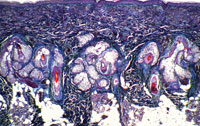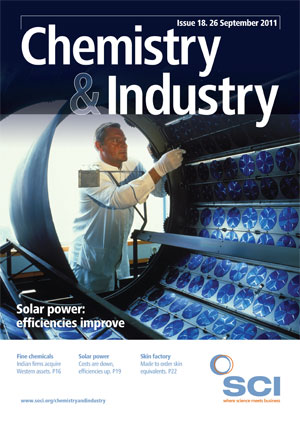The increasing demand for reduced animal testing in consumer product development has led to a growing market for in vitro test systems. Indeed, public and regulatory requirements force producers to use alternative methods for testing the safety of new substances or products when applied to human skin. However, manual state-of-the-art processes for producing human skin equivalents or models, are expensive and time-consuming and thus not suited to high volume production. To produce skin models at a reasonable price and of consistent quality, researchers and engineers at the Fraunhofer- Gesellschaft in Germany are developing the first fully-automated system for producing human skin models, by re-engineering the current complex and labour-intensive manual manufacturing protocol.
The Fraunhofer team has already produced a prototype of the automated system that integrates a variety of novel tissue and cell handling devices and cultivation procedures. The final system will not be limited to the automated manufacturing of in vitro skin models, but should find broad application in cell cultivation and tissue engineering. Since the system design is based on state-of-the-art requirements for industrial tissue engineering, such as good manufacturing practice (GMP), it also offers the potential for the automated production of cells for human transplants.
The skin model
The skin model is assembled using living human cells – keratinocytes and fibroblasts – obtained from biopsy and then embedded in a collagen scaffold. Keratinocytes differentiate within the model to form a multi-layered epidermis with a well stratified uppermost layer – the stratum corneum – simulating an important barrier to the penetration of substances through the skin. This double-layer model allows the detailed investigation of different types of interaction between outermost epidermal and underlying cutaneous cells, which offers the possibility of testing products for their corrosive and irritant effects. Active ingredients in cosmetic or pharmaceutical products can therefore be tested in vitro using this model.
The first step in the assembly of the threedimensional skin model is the even distribution of fibroblasts into a collagen matrix, avoiding high shear stress to the cells and clogging of the collagen matrix. After one day of fibroblast cultivation on this matrix, human primary keratinocytes are added to the top of the matrix to establish the dermal layer. Controlled flow rates are maintained to avoid dermal layer penetration. Over the course of the cultivation process, the initially fully submersed system is changed to an ‘air–liquid’ system, which is the signal to the keratinocytes to differentiate and stratify to form the stratum corneum.
Monitoring and controlling the automated production of skin models requires the integration of a broad spectrum of metrological instruments to guarantee high quality products. Application-specific sensor solutions have been developed and integrated into the system to monitor the production process and provide quality control for each individual skin model before leaving the tissue factory. With this set up, growth parameters of cells and tissues – their density, vitality, turbidity, shape etc – are captured during the cultivation processes and emerging contaminations of cultivation media are detected at an early stage.
At the end of the process chain, each skin model is characterised non-invasively by an automated Optical Coherence Tomography (OCT) system. Implementation of this quality management system ensures a high level of process reliability.
Looking forward
In addition to the automated processing of human donor tissue, Fraunhofer researchers are developing alternative cell sources, including, for example, induced pluripotent stem (IPS) cells. IPS cells are similar to human embryonic stem cells, even though they are derived from human fibroblasts. The reprogramming into stem cells is induced by specific transcription factors such as mRNA. IPS cells produced by this method have potential in regenerative medicine, because they can be generated individually for each patient. The researchers aim to use these IPS cells to generate keratinocytes and fibroblasts for making skin models that match the quality of those derived from cells extracted by biopsy.
In parallel to the technical and biological R&D, the Fraunhofer team conducted market analysis to steer the project towards industry demands. Their results showed a fast growing European market – +20% /year – especially after 2013. The study suggests a market demand of at least 1.8m units of skin models/year in Europe, which is estimated to be worth around €100m.
Additionally, the market research included an analysis of companies producing skin models and their potential customers, to derive quality requirements for the automated production system and product skin equivalents. This revealed significant market potential for both low-cost, single-layer systems with authority-validation for toxicity testing as well as complex multi-layer systems for product development and efficacy testing.
The building of the tissue factory prototype started in early 2011 and is ongoing. Maintaining all capabilities required for producing multi-layer skin models, the system is currently being optimised for the parallel production of single-layer models as well as customised multi-layer models featuring specific cell types or disease characteristics. The short- to mid-term objective of the project is the production of a wide range of different tissue models. This includes standardised, validated single-layer models as well as customised multi-layer models.
Furthermore, all changes and system modifications necessary for the automated production of cells for human transplants are being identified in order to develop a transplant production system based on the technology currently used in the tissue factory. Closely following market and regulatory developments, current efforts are focused on cartilage transplants, with the longterm goal of the automated production of a range of vascularised tissue and organ transplants.
Three-dimensional skin equivalents
Manufacturing three-dimensional skin models starts with the extraction of primary human fibroblast cells and primary human keratinocytes from human biopsy. These two cell types are coaxed to divide and replicate separately before being used to grow the dermal and epidermal tissue structure. The overall production system consists of three main modules: cell extraction, cell expansion and tissue cultivation, integrated in a laminar flow housing and controlled by a central computer system.

The process continues with the seeding and cultivation of the isolated primary cell types in specific cell culture flasks in MTP (micro-titre plate) format for automated handling. With an overall capacity of 500 flasks, the cells are cultivated according to an optimised protocol specifically adapted to the automated process. Cell density, cell vitality, cell shape and the pH are continuously monitored throughout the cultivation process.
Heike Walles is head of the department of cell and tissue engineering at the Fraunhofer-Institute for Interfacial Engineering and Biotechnology in Stuttgart; and Diana Pickert is a research associate in life science engineering at the Fraunhofer-Institute for Production Technology in Aachen, Germany.





